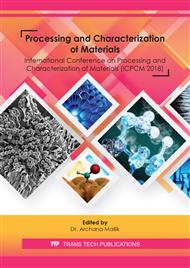[1]
L. Paul, and S. S. Hiremath, Experimental and theoretical investigations in ECDM Process–An Overview, Procedia Technology. 25 (2016) 1242-1249.
DOI: 10.1016/j.protcy.2016.08.216
Google Scholar
[2]
L. Paul, and S. S. Hiremath, Improvement in machining rate with mixed electrolyte in ECDM process, Procedia Technology. 25 (2016) 1250-1256.
DOI: 10.1016/j.protcy.2016.08.218
Google Scholar
[3]
M. Singh, and S. Singh, Electrochemical discharge machining: A review on preceding and perspective research, Proceedings of the Institution of Mechanical Engineers, Part B: J. Engg. Manuf. (2018) 0954405418798865.
Google Scholar
[4]
N. Sabahi and M.R. Razfar, Investigating the effect of mixed alkaline electrolyte (NaOH+ KOH) on the improvement of machining efficiency in 2D electrochemical discharge machining (ECDM), Int J Adv Manuf Technology.95 1-4 (2018) 643-657.
DOI: 10.1007/s00170-017-1210-4
Google Scholar
[5]
L.Paul and S. S. Hiremath, Response surface modelling of micro holes in electrochemical discharge machining process, Procedia Engg. 64 (2013) 1395-1404.
DOI: 10.1016/j.proeng.2013.09.221
Google Scholar
[6]
M. R. Dhanvijay and B. B. Ahuja, Micromachining of ceramics by electrochemical discharge process considering stagnant and electrolyte flow method, Procedia Technology. 14 (2014) 165-172.
DOI: 10.1016/j.protcy.2014.08.022
Google Scholar
[7]
O. P. Gupta and V. Yadava, Machining of borosilicate glass by ECDM process: comparison of machining performance during drilling and sinking holes, ELK A. Pac. Journals. 56 (2016).
DOI: 10.16962/elkapj/si.arimpie-2016.56
Google Scholar
[8]
S. K. Jui, A. B. Kamaraj and M. M. Sundaram, High aspect ratio micromachining of glass by electrochemical discharge machining (ECDM), J. of Manuf. Processes. 15.4 (2013) 460-466.
DOI: 10.1016/j.jmapro.2013.05.006
Google Scholar
[9]
K. R. Kolhekar and M. Sundaram, A study on the effect of electrolyte concentration on surface integrity in micro electrochemical discharge machining, Procedia CIRP. 45 (2016) 355-358.
DOI: 10.1016/j.procir.2016.02.146
Google Scholar
[10]
T. Singh, and A. Dvivedi, On pressurized feeding approach for effective control on working gap in ECDM, Mat. and Manuf. Processes. 33.4(2018) 462-473.
DOI: 10.1080/10426914.2017.1339319
Google Scholar
[11]
F. Mehrabi, M. Farahnakian, S. Elhami, and M.R. Razfar, Application of electrolyte injection to the electro-chemical discharge machining (ECDM) on the optical glass, J. Mat. Processing Technology. 255 (2018) 665-672.
DOI: 10.1016/j.jmatprotec.2018.01.016
Google Scholar
[12]
Y. Xu, J. Chen, B. Jiang, Y. Liu, and J. Ni, Experimental investigation of magnetohydrodynamic effect in electrochemical discharge machining, Int. J. Mech. Sciences 142 (2018) 86-96.
DOI: 10.1016/j.ijmecsci.2018.04.020
Google Scholar
[13]
B. Mallick, M. N. Ali, B. R. Sarkar, B. Doloi and B. Bhattacharyya, Parametric analysis of electrochemical discharge micro machining process during profile generation on glass, Aimtdr (2014) 1-6.
DOI: 10.4028/www.scientific.net/amm.592-594.525
Google Scholar
[14]
L .Paul and S. S. Hiremat, Evaluation of process parameters of ECDM using grey relational analysis, Procedia Mater. Sci. 5 (2014) 2273-2282.
DOI: 10.1016/j.mspro.2014.07.446
Google Scholar
[15]
J.West and A.Jadhav, ECDM methods for fluidic interfacing through thin glass substrates and the formation of spherical microcavities, J. Mic.mech Mic.engg. 17 (2007) 403–409.
DOI: 10.1088/0960-1317/17/2/028
Google Scholar
[16]
X. Kang and W. Tang, Micro-drilling in ceramic-coated Ni-superalloy by electrochemical discharge machining, J. Mat. Processing Technology 255 (2018) 656-664.
DOI: 10.1016/j.jmatprotec.2018.01.014
Google Scholar
[17]
M. CoteaţǍ, N. Pop, H. P. Schulze, L. SlǍtineanu and O.Dodun, Investigation on hybrid electrochemical discharge drilling process using passivating electrolyte. Procedia CIRP. 42 (2016) 778–782.
DOI: 10.1016/j.procir.2016.02.318
Google Scholar
[18]
S. Huang, D. Zhu, Y.B. Zeng, W. Wang and Y. Liu, Micro-hole machined by electrochemical discharge machining (ECDM) with high speed rotating cathode, Adv. Mat. Research, Trans Tech Publications 295 (2011) 1794-1799.
DOI: 10.4028/www.scientific.net/amr.295-297.1794
Google Scholar
[19]
Z. Zhang, L. Huang, Y. Jiang, G. Liu, X. Nie, H. Lu and H. Zhuang, A study to explore the properties of electrochemical discharge effect based on pulse power supply, Int. J. Mach. Tools Manuf. 50 ( 2010) 689–697.
DOI: 10.1007/s00170-015-8302-9
Google Scholar
[20]
S. K Chak, Electro Chemical Discharge Machining: Process Capabilities, Int. J. Mech. Prod. Engg. 48 ( 2016) 2320–(2092).
Google Scholar
[21]
T.Weidong, X.kang and Z.Wansheng, Enhancement of electrochemical discharge machining accuracy and surface integrity using side-insulated tool electrode with diamond coating, J.mic. and mic, engg. 27 6 (2017) 065013.
DOI: 10.1088/1361-6439/aa6e94
Google Scholar


